Apple iPad mini with Retina Display: Reviewed
by Anand Lal Shimpi on November 16, 2013 8:00 AM ESTThe Display
The big story behind the new iPad mini is of course its 7.85-inch Retina Display. We’re talking about the same 2048 x 1536 resolution as the iPad Air, but in a much smaller form factor. The result is the highest pixel density of any Apple display ships today, tying with the iPhone 5S. The impact on the overall experience is pretty significant. Text is obviously a lot sharper, but even graphics are a lot nicer to look at on the new Retina Display. The gains aren't quite as obvious as they were on the larger iPad, but after living with the Retina mini for a while I can't easily go back to the previous version.

iPad mini (left) vs. iPad mini with Retina Display (right)
I ran Marco Arment's image retention test on the Retina mini and didn't see even the slightest degree of image retention. My old, non-Retina iPad mini on the other hand exhibited image retention. I suspect Apple is multi-sourcing its displays here, which could obviously contribute to varied behavior. At least on the two minis I have, image retention isn't an issue.
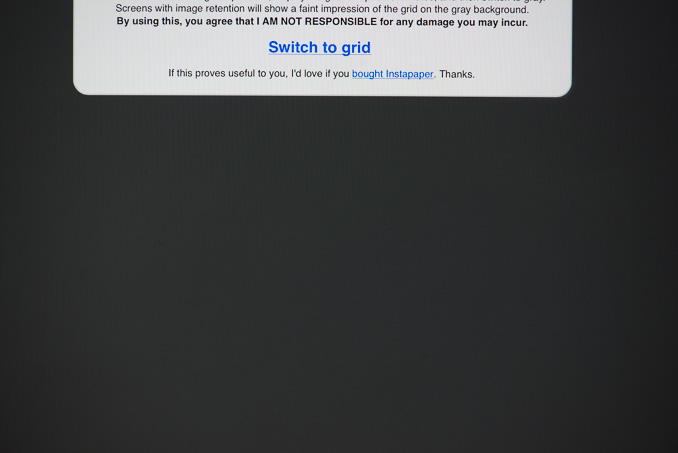
In the conclusion of my iPad Air review I wrote about the new mini as finally being a no-compromises smaller iPad. Much like my assertions last year of a Retina mini not being in the cards, it turns out that I was wrong on this point as well. Although display resolution is no longer a concern on the mini, color gamut hasn’t changed between the old and new minis. A quick look at our gamut test gives us an idea of what’s going on:

The iPad mini with Retina Display has the same color gamut as the standard iPad mini, which is narrower than the iPad Air and less than the sRGB coverage we normally look for. The biggest issue here is that there are other smaller tablets in this price range that do offer sRGB coverage (e.g. Nexus 7, Kindle Fire HDX 8.9).
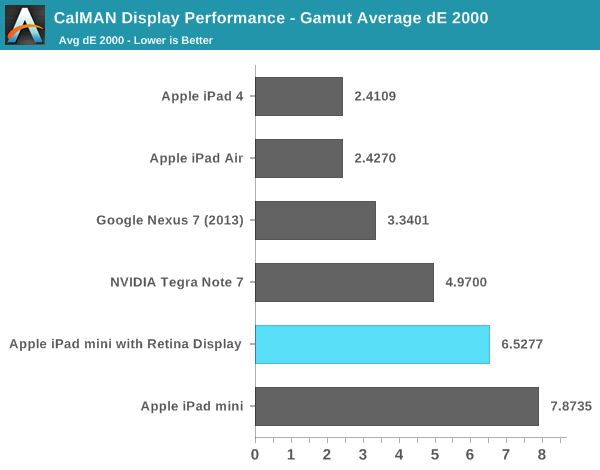
I suspect the justification here is Apple likely views the bigger iPad as being a better fit for photographers/those who care about color reproduction, but it’s a shame that this is a tradeoff that exists between the two iPads especially given how good Apple is about sRGB coverage in nearly all of its other displays.
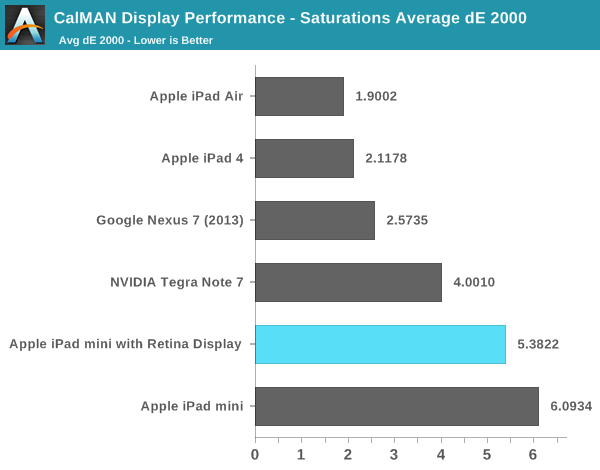

One of the simplest visual tests is to use one of iOS 7’s more colorful wallpapers and compare the Retina mini and iPad Air side by side:
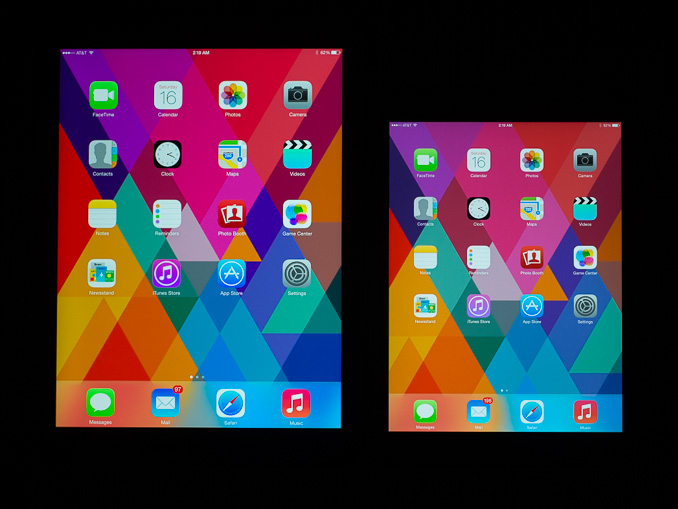
Pay attention to the color of the red triangles in the lower left
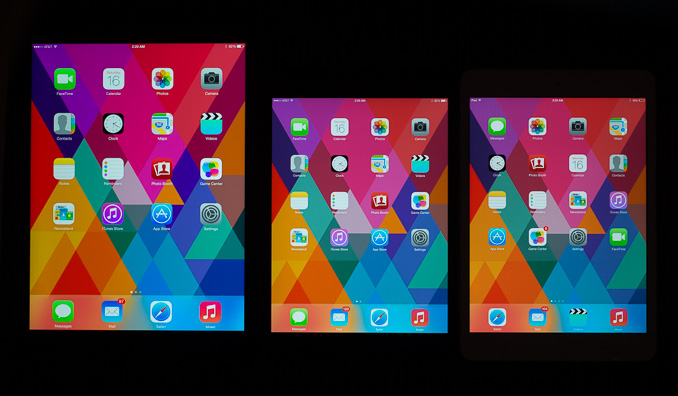
From left to right: iPad Air, iPad mini with Retina Display, iPad mini
The difference is small but apparent, particularly if you’re used to panels with full sRGB coverage like the iPad Air or any of the rMBPs/iMacs. The biggest deviations are in reds/blues and magenta in between as you can tell from the CIE chart above.

Within its gamut coverage, the mini’s panel is fairly accurate. A look at our GMB checker test shows performance competitive with the Nexus 7 and not far off the 4th generation iPad. Grayscale reproduction is also quite good. The display looks really good otherwise, but you don’t get the same visual punch you do on the iPad Air.
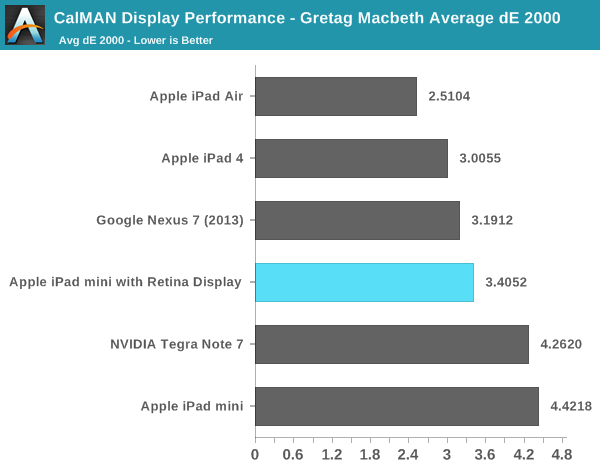

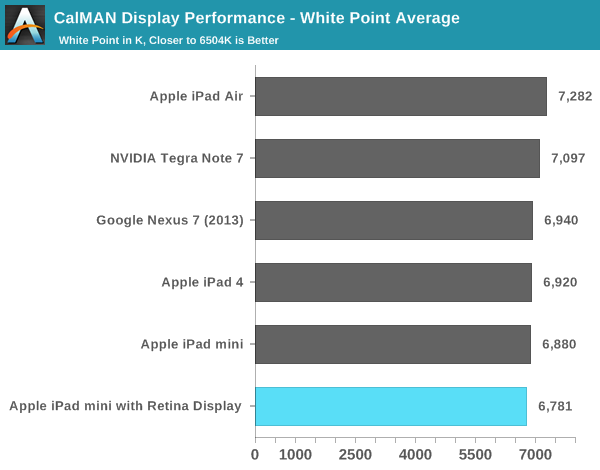
Compared to the previous generation mini we’re obviously talking about a much better panel. But for those of you on the fence between the mini and Air, the Air does still hold a display advantage.
Black levels are competitive and contrast ratio stays fixed at around 800:1 regardless of whether we’re talking about max brightness or the 200 nits we run all of our battery life tests at. Max brightness is down a bit compared to the iPad Air.
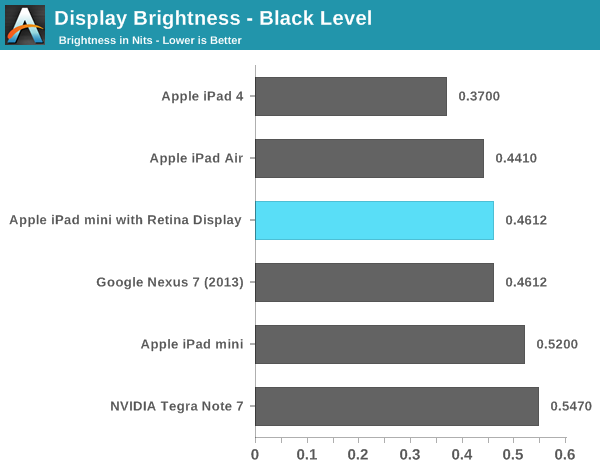
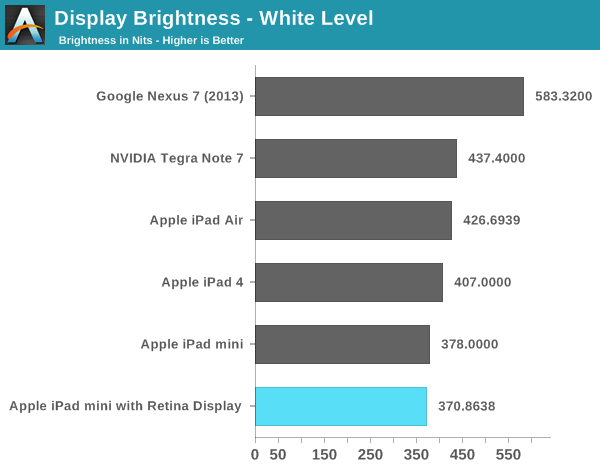
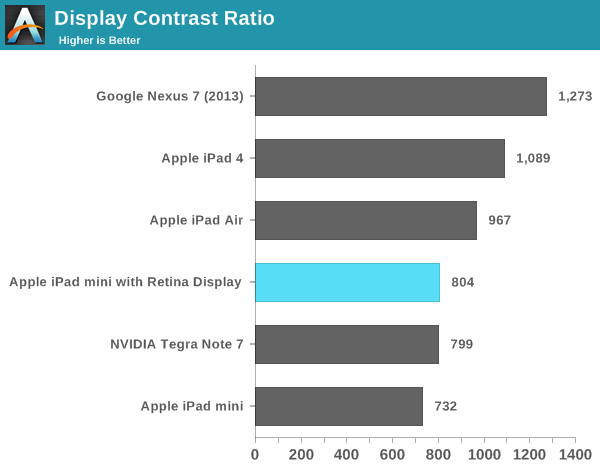










345 Comments
View All Comments
socio-statistical - Monday, November 18, 2013 - link
Yeah, but, if the article is fair, then it's not promoting Android...KPOM - Saturday, November 16, 2013 - link
How does he say Apple can do no wrong? He pointed out that the mini isn't a "no compromises" device as he had hoped, and has given high marks to competing devices from Google and Samsung.MrX8503 - Saturday, November 16, 2013 - link
The Verge also said it was a "no compromises" device. Its a great tablet, admit it.kji875 - Saturday, November 16, 2013 - link
False. Every 32 bit ARM device is compromised because of the lack of native compatibility with x86 apps, traditional UI, and features.chaosbloodterfly - Saturday, November 16, 2013 - link
*points out* A7 is 64 bit ARM.ws3 - Saturday, November 16, 2013 - link
By those standards every supercomputer on the top 500 list is "compromised" because none of them run Windows.zeagus - Monday, November 18, 2013 - link
Point!abazigal - Saturday, November 16, 2013 - link
I would argue that that's the main reason why I love my iPad - precisely because Apple had the foresight and common sense not to try and shoehorn a desktop OS into a tablet form factor.darkcrayon - Saturday, November 16, 2013 - link
Then I guess they're also "compromised" by not running some of the awesome classic 8 bit Apple ][ games natively? Not sure you're using "compromised" in the way people are generally talking about with tablets.Cptn_Slo - Sunday, November 17, 2013 - link
x86 doesn't work well on tablets, or else MS would be selling Surfaces like crazy.